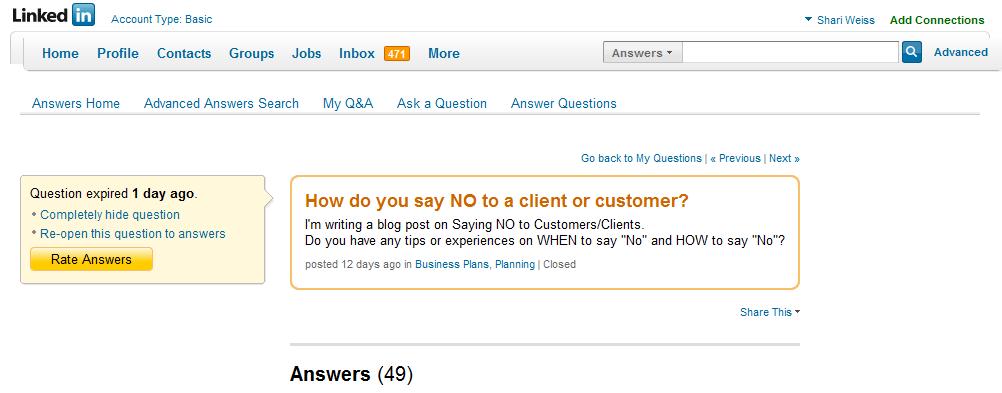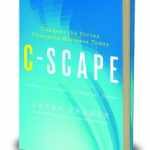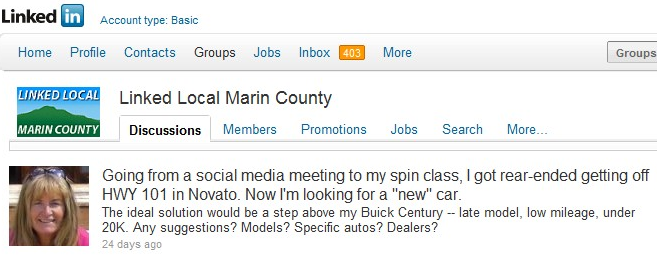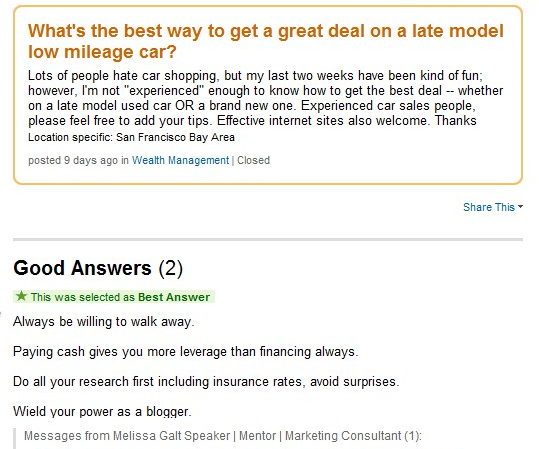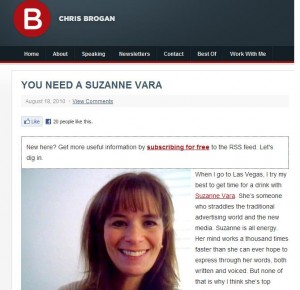“Call me insane, but I’ve always assumed that like myself, clients are human and therefore capable of ‘occasionally’ being confused, misinformed, or simply WRONG.
With this mindset I believe that saying ‘No’ to the client is perfectly acceptable just as long as you’re considerate about how you go about it.”
— from one of 49 LinkedIn Answers
For the final installment of my 6-part series on How to Say NO to new clients, I am featuring a half dozen of the 49 responses submitted in response to my LinkedIn question:
[if you click on the image above, you will be able to read all 49 responses]
We’ll get to those answers momentarily, but first I’d like to list the steps in using this LinkedIn feature:
- Click on the MORE tab at the top of the LinkedIn Menu Line.
- The Drop Down box lists ANSWERS as the second option; click on it.
- The next screen will give you a box to write in a question. Keep it short and interesting.
- After you press “Next,” you can add details below the question.
- On this same screen, you will pick a category and post your question.
People actually scour LinkedIn for questions to answer: This strategy builds their Online Expertise. I know people who answer 50 questions a day! And you can do the same.
Or, you can get lots of your own questions answered by lots of experts — and then connect with anyone’s response that you like, start building a relationship, and even hire them [or vice versa]. LinkedIn allows you to ask 10 questions every month.
And now six of the 49 answers to my question: “How do you say NO to a client or customer?”
Hello Shari,
For as long as I can remember, I’ve been bombarded with the idea that “the client is always right” and to be honest, it never quite sat right with me.
Call me insane, but I’ve always assumed that like myself, clients are human and therefore capable of “occasionally” being confused, misinformed, or simply WRONG. With this mindset I believe that saying “No” to the client is perfectly acceptable just as long as you’re considerate about how you go about it.
While “every client is different and unique”, here’s what I believe to be the best strategy for saying “No” to a client. (Your Mileage May Vary)
1) Educate
Nobody likes getting shot down without a reason, so explain why you need to say “No” By providing insight into your decision making process you can help the client feel more informed.Customer service is key here, but when it’s done right this can also help remind them that you’re the expert and they came to you for a reason. Besides…if you can’t explain why you’re saying “No” how can you ensure you’re not the one who’s wrong?2) Give them Options
Now that you’ve educated your client on why you’ve said “No”, they might be left feeling a little foolish or maybe even frustrated. To help overcome this and get your project back on track, you need to restore their confidence and feeling of control. Provide the client with a short list of carefully researched recommendations so that they can make a “controlled decision” and you’re not left saying “No” again.While I admit that this is over simplified version, and it’s often a lot more work than it sounds like when done right, education and options are a solid defense for saying no while still keeping the client (somewhat) happy.
I hope this gives you something to think about.
I get the customer to put everything he asks for in one list, and order it by priority. Then I say how far down the list we can get, for a certain amount of money or by a certain date. If the customer wants more, or different, then we talk about it. This works for most things the customer asks for, and it means that it is the customer who says yes or no.
The difficult bit is to get the flexibility to be able to respond to the customer when he makes a decision on scope or priority, and if one can’t respond well, to time that discussion so that you can respond to the decisions, but the customer already knows enough to make good decisions. Work on being able to respond effectively later; and where these possibilities are severely limited work on being able to bring the customer to a better understanding earlier.
Hi Shari,
I do have come across many instance where as a company we had no option but to say “No” to prospects/clients due to many different reasons.
In such circumstances, I’d say- As much as we would like to work with you however due to limiting circumstances such as limited budget that you have, our tight staff schedule or lack of expertise in your technology preference, we are very sorry for not being able to work on this project.
We thank you for giving us an opportunity to work with you and look forward to similar opportunities soon.
When I say “no” to a Client, I try to always find a graceful way for him to save face and, if possible, to help point him in the direction of somebody who can say “yes.”
There are ways of saying “no”, and there are usually ways of saying it that won’t come across as outright rejection. You always want to avoid leaving your Client feeling rejected, or that you are unwilling to help him solve his problems: that is what causes Clients to go find somebody who can.
Avoid using trite Bad News phrases like “We regret to inform you that…” because nobody likes to receive a ‘Dear John’ letter. Much better to say “I can’t do it this time, tho’ I’d really like to: thanks for thinking of me. Why not call Joe Blogs? He’s very good at this sort of thing, and I’ve got his number right here…”
This achieves several things: it acknowledges the compliment your Client has paid you by asking you to do something. You’ve politely declined. You’ve still been helpful by sending him to Joe Bloggs, and with any luck Joe Bloggs will appreciate the referral and return the favor one day. Nobody loses face, everybody remains happy.
One silly reason to say “no” is you have been asked to do more than what you contracted for. Instead, you need to politely identify the change in scope with your Client, and ask for more time and more money. Most people are reasonable about paying for extra work. If your Client isn’t one of those people, tho’, and if they refuse your reasonable request outright, it’s time to say “no” — however, you still need to allow him to save face and have his problems solved somehow.
“I wish I could do this extra work for free, I can see you really need it. If I did it would be unfair to my other Clients, who need my time and are willing to pay for it. Why not try Joe Bloggs? He might be willing to do a “pro bono pro gratis”, to help you out. I’ve got his number right here…”
This too achieves a few things. It acknowledges the compliment of being asked to do more: he must be happy with your work, else he wouldn’t have asked. It reinforces that the work needs to be done. It gives a perfectly valid reason why you can’t do the work for free. And best of all, it provides a way that he can ask someone else — if he has the bold-face effrontery — to do it for nothing. Businesses aren’t charities, your Client knows that, and chances are he’ll come around to see reason. If he doesn’t, that might be a good time to do some Client Re-Qualification.
The 3 primary reasons that any business owner is forced to say ‘no’ to a customers are a) the request is out of the scope of the services provided or they can’t provide the goods or services in the time frame or price requested b) they are backlogged and don’t have the time or manpower or c) the customer isn’t clear about what they want, when they want it or how much they wish to spend.
The last one relates more to the service sector rather than companies that sell products but anyone who has worked as a consultant or in the design/technology sector can relate to the angst we go through when a client doesn’t understand clearly what they want to achieve, doesn’t understand the costs and/or time involved or even worse, thinks that they do. These are the kind of customers that require a simple ‘no’, however you want to spin it.
Shari, perhaps the follow up should be How and When to fire a customer/client.
I think the answers that recommended saying “no” with an explanation, and referring the customer to others who might do the job, is usually the best way to do it. Very professional.
One thing I have not seen so far, if the job is actually one you can do well but there is something about the customer or the job that you would like to avoid, is to say “yes” with a price that is so high that the customer will inevitably choose another vendor. For example, if the customer is a chronic late payer and you have tried to address the problem with no success, this might be the best solution. If for some reason the customer chooses you anyway, the high price can be thought of as a built-in late payment fee.
Previous Series Posts:
Post #1: Saying NO to a prospective client may be the Best Business Move
Post #2: Avoid future problems by saying NO Now
Post #3: Investigate client/project before saying Yes — or making it a NO.
Post #4: Three main reasons to say NO to new client
Post #5: Saying NO is easy
Did this “series” work for you? If you are a blogger, have you done a series or two? What have you learned?
